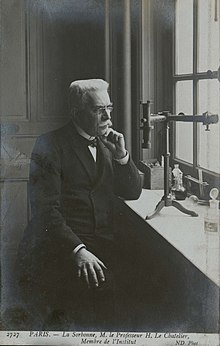Henry Le Chatelier
Henry Louis Le Chatelier (born October 8, 1850 in Paris , † June 17, 1936 in Miribel-les-Échelles , Département Isère ) was a French chemist , metallurgist and physicist who made important contributions to thermodynamics .
Le Chatelier was the son of mining engineer and entrepreneur Louis Le Chatelier . He was interested in chemistry , metallurgy and mathematics while still at school . After finishing school, he studied at the École polytechnique from 1869 and at the École Nationale Supérieure des Mines and also attended chemistry lectures. In 1873 he received his doctorate under St. Claire Deville at the University of Paris and taught chemistry between 1878 and 1925, successively at the École des Mines, at the Collège de France and at the Sorbonne . In 1907 he was promoted to general inspector of the École des Mines. In the same year he became a member of the Académie des sciences . The Prussian Academy of Sciences accepted him in 1905 as a corresponding member. In protest against the appeal to the world of culture , he resigned on March 15, 1915. In 1913 he became a corresponding and in 1926 honorary member of the Russian Academy of Sciences . He became a foreign member of the Royal Society in 1913. In 1919 he was elected to the American Academy of Arts and Sciences .
In 1888 he formulated a thermodynamic principle that is now known as the principle of the smallest compulsion or Le Chatelier-Braun principle. According to this principle, a system that is in a state of equilibrium tries to compensate for external constraints (changes in state variables ) by adapting the other state variables. Le Chatelier also looked at the specific heat capacity of gases at high temperatures and devised a thermoelectric pyrometer that could measure temperatures above the range of a mercury thermometer .
Le Chatelier advocated broader application of chemistry in French industry ; his research paid off in products such as ammonia , cement , steel and ceramics . One of his works is De la méthode dans les sciences expérimentales (1936). Le Chatelier was a member of numerous scientific institutions and received various awards.
Web links
- Literature by and about Henry Le Chatelier in the catalog of the German National Library
- Entry for Chatelier, Henry Louis Le (1850-1936) in the Archives of the Royal Society , London
Individual evidence
- ^ Biographical data, publications and academic family tree of Henry Louis Le Chatelier at academictree.org, accessed on February 25, 2018.
- ^ List of members since 1666: Letter L. Académie des sciences, accessed on January 10, 2020 (French).
- ^ Historical academy members: Henry-Louis Le Chatelier. Berlin-Brandenburg Academy of Sciences and Humanities, accessed on January 10, 2020 .
- ^ Foreign members of the Russian Academy of Sciences since 1724: Le Chatelier, Henry Louis. Russian Academy of Sciences, accessed January 10, 2020 (Russian).
| personal data | |
|---|---|
| SURNAME | Le Chatelier, Henry |
| ALTERNATIVE NAMES | Le Chatelier, Henry Louis (full name) |
| BRIEF DESCRIPTION | French chemist, metallurgist and physicist |
| DATE OF BIRTH | October 8, 1850 |
| PLACE OF BIRTH | Paris |
| DATE OF DEATH | June 17, 1936 |
| Place of death | Miribel-les-Échelles , Isère department |

